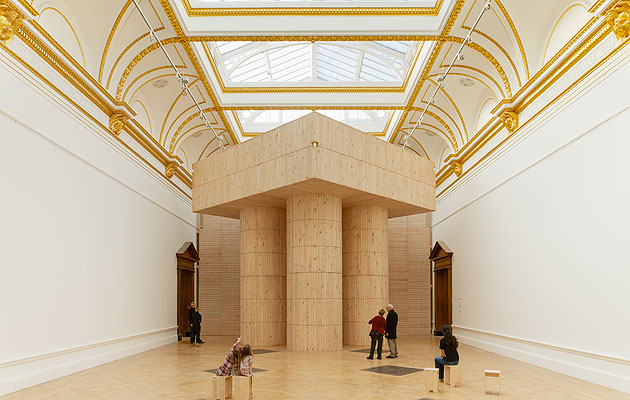|
|
||
|
Towards the end of this exhibition,I overheard a man murmuring to his partner that he would like something like this in their house. It was an incongruous comment, in the middle of a twig-lined maze by Chinese architect Li Xiaodong: a concerted mental effort to fill the gap, whichthe exhibition deliberately leaves empty, between the abstract space-making on show, and the shaping of real buildings. The Royal Academy has commissioned a series of seven installations, from six architects, in its main gallery suite. It’s a bold move away from didactic retrospectives of respected architects and towards showing the “experience and power” of architecture. But it is playing catch-up with its audience, who are well used to sensing space through installation art, immersive theatre, pop-ups and pavilions. The RA has broken new ground relative to its own programme only, rather than providing a new insight into architecture itself. That’s not to say the show doesn’t have its fun moments. Children play hide-and-seek on the spiral stairs within Pezo von Ellrichshausen’s wooden elephant-legs, running up to a chunky balcony with peepholes at eye-level with the gilded 19th-century cornicing. Diébédo Francis Kéré’s tunnel of white plastic honeycomb into which visitors can push coloured straws, transforming it into a jolly hairy mess, is the hit of the show; smiles break the usual middle-distance gazes, and adults and children alike enjoy the simple opportunity to make something for themselves. Li Xiaodong’s maze is the one installation in which you genuinely forget where you are, as visitors surprise each other in cubbyholes, and crunch their way across the stones of a mirror-walled “garden”. |
Image Royal Academy of Arts, London; photography by James Harris
Words Hana Loftus |
|
|
||
|
|
||
|
Most architects are not generally good at gallery installations, although they like to think otherwise. The younger architects in the exhibition find relative success through creating narrative or function – inviting the visitor to actually do something, rather than creating a static installation that inevitably lacks the subtlety or power that an artist, tuned to these conditions, can create. Who wants Grafton Architects’ MDF painted to look like concrete, or Souto de Moura’s cast replicas of a couple of doorways, when you’ve experienced a Rachel Whiteread installation? It would be charitable not to mention the great Álvaro Siza’s contribution, which manages the opposite trick to Grafton’s in making concrete look like stained MDF; Kengo Kuma’s installation of scented bamboo is sweet but slight. It’s a shame that these architects, whose built work is so rich in experiential delight, haven’t risen to the challenge as well as their younger selves might have done. |
||
 |
||
|
The question remains: what can a gallery exhibition bring to a public that, despite the soul-searching within the profession, already feeds its fascination with architecture through everything from Grand Designs to ticking off the Chipperfield museums? If it is the opportunity to compare seven approaches to the same challenge – an upmarket Ideal Home Show, condensing a week-long tour into a few hours – the brief in this instance is too vague to allow useful comparisons. If it is to enable boundary-pushing experiments with form and material, again the exhibition disappoints. No true experimentation is found: rather the rehashing of ideas that are better expressed in the “real” buildings of the featured architects. Celebrating the experience of architecture rather than its theory is the right instinct – an approach vindicated by the evident pleasurethat visitors were taking in the best of these installations. But the audience, at least on my busy Saturday visit, showed a great deal of unanswered curiosity about how the pieces were constructed, and an unusual attentiveness to a 15-minute documentary about the architects and their “real” work: the kind of thing that gallery audiences generally skip. This surely indicates a desire to understand more aboutthe translation of abstract “space” into actual buildings; or when something is architecture rather than art. Finding the balance between experience and explanation remains the curator’s challenge. |
||





















